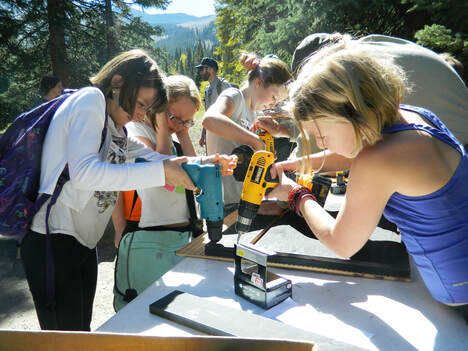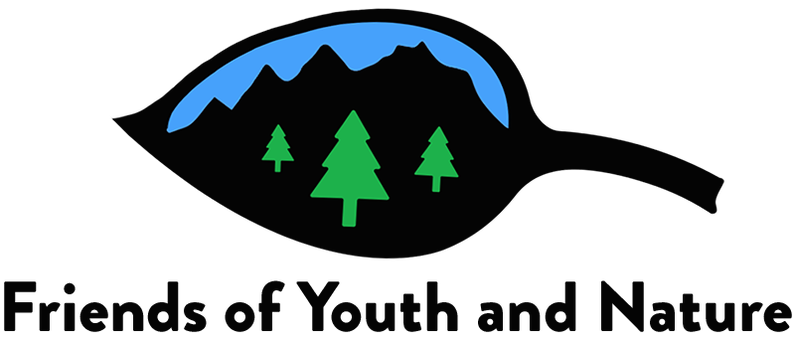|
Tips to help you connect your family to nature!
|
|
Students build blue bird nesting boxes as part of a Public Land Day celebration on the Grand Mesa, Uncomaphgre and Gunnison National Forest. This effort is to help kids learn about our local natural resources on public lands and engage in actions that teach them how to become stewards of our environment As the end of the year approaches, many households are starting to consider where to direct year-end giving dollars. There are many crucial needs in our community that deserve support; in a perfect world, we would be able to fund every cause, but in the real world you’ll need to make choices about where to contribute your year-end donations in a way that aligns with your values and your hopes for the future. If youth mental health, resiliency, and public lands are important to you, then supporting programs to get western slope kids into outdoor educational and recreational programs provides a long-term solution for those issues facing our youth, and our community at large. What impact does an early introduction to the outdoors have on who a child will become as an adult, and how are they affected physically, mentally, and emotionally as they grow up? As it turns out, childhood exposure to outdoor activities can be directly connected to positive long-term outcomes in these areas. Physical Wellness Children are increasingly neglecting outdoor play in favor of the digital world—reducing kids’ screen time is often a major struggle for parents. Computers, mobile devices, and video games are passive forms of entertainment, and they don’t call for physical coordination, strength, endurance, or any of the other attributes necessary for a healthy body. Outdoor play, on the other hand, promotes all of these things, and is a natural method of encouraging physical activity in young people. A 2015 metanalysis of studies regarding the effects of time spent outdoors on children found, “outdoor time is positively related to physical activity and negatively related to sedentary behavior in children aged 3–12 years'' (https://www.mdpi.com/1660-4601/12/6/6455). The more outdoor time children have, the more physical activity they take part in and, conversely, the less sedentary behavior they display. Mental Health & Resiliency Many people spend time outdoors because it brings them a sense of happiness and well-being. If adults need to get away to nature every now and then to stay happy, surely children must benefit from these quieter natural spaces as well. Perhaps unsurprisingly, a 2018 study showed that the more time children spend in nature and the greater sense of connection they personally feel with nature, the less likely they are to experience psychosomatic symptoms such as irritability, anxiety, difficulty sleeping, headache, stomach ache, backache, and other maladies. The benefits start with as little as 30 minutes of outdoor activity per week (https://pubmed.ncbi.nlm.nih.gov/29679604/). As we consider ways to address the increasing prevalence of mental health challenges in young people, including a disproportionately high suicide rate in our area, outdoor activities can play a crucial role in building resiliency and promoting mental well-being in our youth. Stewardship of Public Lands Physical activity, cognitive development, and emotional well-being are relatively easy to quantify in research. But what about something like the desire to preserve our natural areas, or an understanding of the importance of good stewardship practices for our public lands—can we quantify these outcomes? Though it’s more difficult to show a correlation between time spent outdoors during childhood and an individual’s likelihood to become a good environmental steward, it has been shown that the amount of time spent outdoors has a direct correlation with a child’s feelings of connection with nature. This sense of connection with the natural world then has a direct influence on behaviors related to environmental stewardship in children such as, “conserving water, turning out lights, recycling, talking about the environment, and picking up litter” (https://scholarworks.umass.edu/cgi/viewcontent.cgi?article=1001&context=nerr). The more time young people spend in the outdoors, the more likely they will become involved with environmental stewardship and preservation of our public lands. As you consider how to distribute year-end donations in our community in a way that most aligns with your values, know that when you donate to organizations that provide opportunities for local kids to get outdoors for science education and recreational field trips, you’re not only directly contributing to their physical and mental well-being—you’re also helping to raise a generation that will value our natural environment and ensure the preservation of public lands for years to come.
4 Comments
3/9/2024 11:57:43 pm
Your recent blog post was a genuine treasure trove of insightful ideas and engaging anecdotes. Your unique writing style, infused with wit, evocative descriptions, and inventive analogies, brought the topic to life in my mind's eye. It felt as though I was accompanying you on the adventure, and I'm excitedly looking forward to your next blog post. I'll be keeping a keen eye out for it.
Reply
Absolutely fantastic article! The insights are not only spot on but also incredibly enlightening. Your expertise shines through and makes a real impact. I can't wait to see more of your outstanding content!
Reply
Leave a Reply. |
Blogs for Summer! DIY Summer Camps A Summer backyard Bucket List Hiking with Children 101 Kids, Dogs and Hikes a Winning Combination Getting Outdoors is Easier than You Think Categories
All
Archive
Archives
July 2024
|



 RSS Feed
RSS Feed


